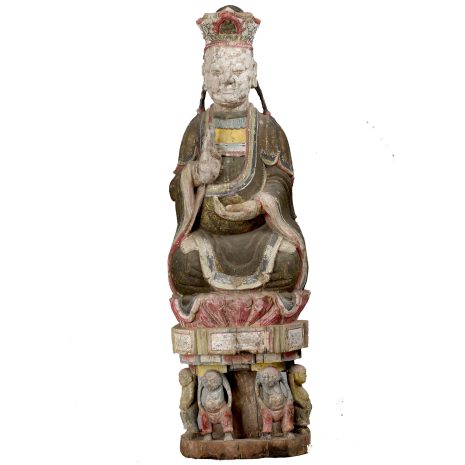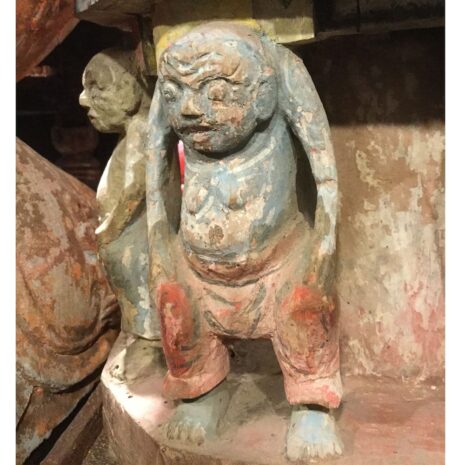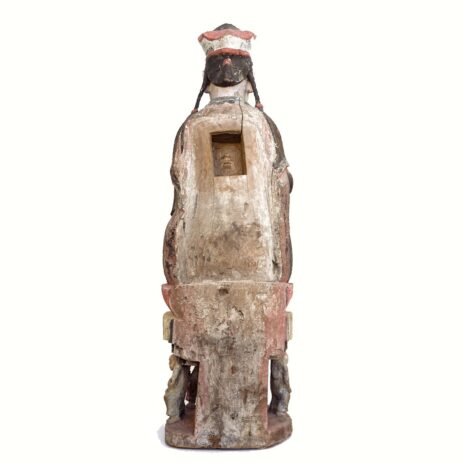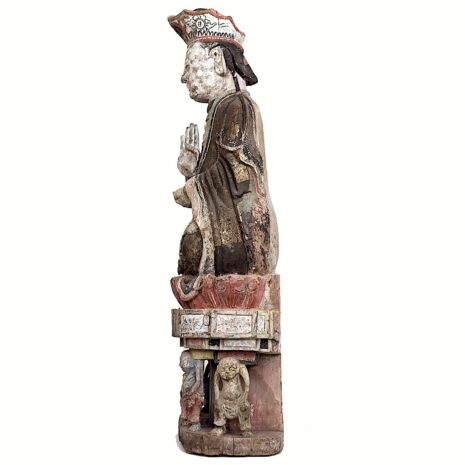Antique Guanyin Held Up by Demons, China (16208)
Original price was: $4,200.00.$3,200.00Current price is: $3,200.00.
H: 45″ W 17.75″ D: 11.5″ | CALL 213-568-3030 OR EMAIL [email protected] FOR SHIPPING
Rare statue of Guanyin held up by 4 creatures in hell remind us that people, like demons, can change and reach enlightenment. Demons are just obstacles – greed, aversion, and ignorance – to overcome through good deeds and thoughts,
Description
During the Ming and Qing Dynasties, Guanyin statues proliferated throughout China’s rural and provincial regions. Created by local talented artisans who drew from their own artistic visions they displayed a hodgepodge of components and symbols. Far from the imperial court they did not follow artistic rules, forms, or and iconography and often combined elements Buddhist, Taoist and Popular Folk Religion traditions. Going so far from proscribed rules, these images reflected local tastes, physical features and appealed to the uneducated populations and thus, were not sanctioned by imperial court, government or religious authorities.
This large rare provincial Guanyin carving shows the influence of Tibetan Buddhism on Mahayana Buddhism at this time It represents the defense of Buddhism against ignorance and demonic forces often portrayed in Tibetan, Nepalese and Tantric Buddhism. In these traditions demons are forces and natural spirits that are not harmful. They are only obstacles – greed, aversion, and ignorance – that each of us must respect, control and overcome through good deeds and thoughts, meditation, observing rituals and offerings of appeasement. While in the lower realms they must “hold up” beings of the highest realms like this Guanyin. They are not relegated to this inferior state forever and remind us that people can change from demons to higher realms in their constant transition toward enlightenment.
Guanyin here sits on an open lotus held up by a thick lotus stem rising from the base through and above her hexagonal shaped throne. Legs are crossed with feet upward resting on the opposite thigh (padmasana). Her left-hand rests in her lap in meditation (dhyana mudra) and the right is raised in protection (abhaya) mudra symbolizing peace and “have no fear.” As part of Pure Land Buddhism Her high lobed crown is centered with Buddha Amitabha of infinite light inside an aureole.
All this is traditional Buddhist iconography, but the four haggard and agonized creatures struggling to hold up Guanyin on their shoulders is unique for traditional Guanyin images. These four grotesque creatures warn us to be more diligent in our spiritual thoughts and actions and follow the Noble Eightfold Path.
This large image was probably placed in a community shrine or in a Guanyin temple. The backs of statues like this were generally unpainted as they were displayed up high against a wall and foreshortened for viewers to view from below. Some areas were repainted as was customary in temple carvings, especially those from provincial areas where paint easily faded in bad weather and was often done by monks. The rear cavity indicates it was consecrated in an eye-opening ceremony by a Buddhist monk.
Rural folk art pieces made during the Ming and Qing Dynasties have been overlooked in the past in Chinese literature and by collectors but are now being recognized for their charming style, artistic merits and inventive designs.
Click here for the Blog Consecrating Wooden Images to Imbue Them with A Life Force.
Sources:
Julia Hirsch, “The Monsters of Buddhism – Inside and Out” in Trycicle: The Buddhist Review, October 31, 2013.
John C Huntington and Dina Bangdel, The Circle of Bliss: Buddhist Meditational Art, Chicago, Serindia Publications, 2003.
Lee Irwin, “Divinity and Salvation: The Great Goddesses of China,” in Asian Folklore Studies, Indiana University, Vol. 49, 1990, pp 53-68.
Meher McArthur, Reading Buddhist Art: An Illustrated Guide to Buddhist Signs and Symbols, London, Thames and Hudson, 2002.
Chun-Fang Yu, “Kuan-yin: The Chinese Transformation of Avalokitesvara” in Latter Days of the Law: Images of Chinese Buddhism 850-1850, Marsha Weidner, Ed. Honolulu, University of Hawaii Press, 1994, p.151-182.
Additional information
| Period | Antique, Qing Dynasty |
|---|---|
| Date | 18-19th Century |
| Materials and Technique | Wood |
| Dimensions (inches) | Ht: 45” W: 17.75” D: 11.5” |
| Dimensions (metric) | Ht: 114.3cm W: 45.08cm D: 229.21cm |
| Weight | 32 lbs |
| Condition | Very good, see description |
| Item Number | 16208VRKE |
| Shipping Box Size | Oversized. Call 213-568-3030 or email [email protected] for shipping. |












